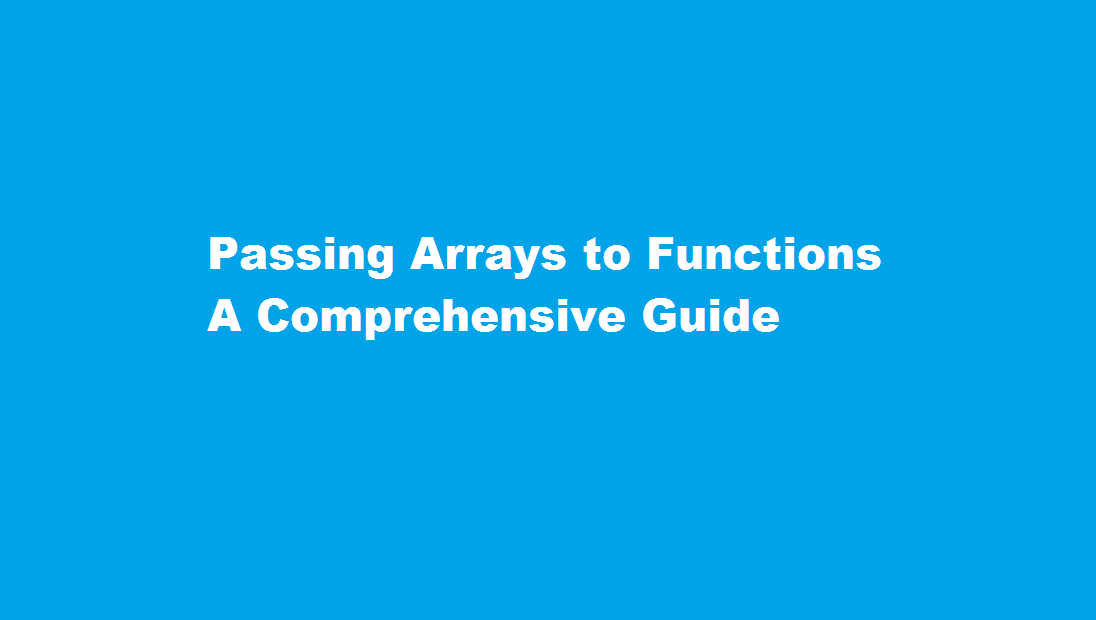Passing Arrays to Functions A Comprehensive Guide


Introduction
Arrays are fundamental data structures in programming that allow you to store and manipulate multiple values. Passing an array to a function is a powerful technique that enables you to work with arrays efficiently and organize your code effectively. In this article, we will explore the concept of passing arrays to functions, understand the benefits it offers, and delve into various approaches and best practices to accomplish this task in different programming languages.
Understanding Array Pass-by-Reference
Before delving into the mechanics of passing arrays to functions, it is crucial to understand the concept of pass-by-reference. In many programming languages, arrays are passed by reference rather than by value. This means that when an array is passed to a function, a reference to the original array is passed instead of creating a copy. This behavior allows modifications made to the array within the function to affect the original array outside the function’s scope.
Passing Arrays to Functions in Different Languages
The process of passing arrays to functions may vary slightly depending on the programming language you are using. Here are some common approaches:
C/C++: In C and C++, arrays are passed to functions using pointers. You can pass either the entire array or a specific subset of elements by specifying the starting address and the number of elements to be passed.
Java: Java allows you to pass arrays to functions directly. The array is passed as an argument, and any modifications made to the array within the function persist outside its scope.
Python: In Python, you can pass arrays to functions as arguments without any special syntax. Python treats arrays as mutable objects, allowing you to modify their contents within the function.
Benefits of Passing Arrays to Functions
Passing arrays to functions offers several advantages
- Code Reusability By passing arrays to functions, you can reuse the same function for different arrays, improving code modularity.
- Modularity and Readability Functions that operate on arrays enhance the clarity and readability of your code, as they encapsulate specific functionality.
- Efficiency By passing arrays by reference, you eliminate the need to create and copy arrays, reducing memory consumption and improving performance.
Best Practices for Passing Arrays to Functions
To ensure effective usage of arrays in function calls, consider the following best practices
- Define Clear Function Signatures Declare function prototypes that clearly indicate the array’s type and purpose.
- Use Meaningful Variable and Function Names Give descriptive names to your array variables and functions to enhance code understanding.
- Document Your Code Provide clear and concise documentation for functions that operate on arrays, including their expected input and output.
- Avoid Global Variables Pass arrays as function arguments instead of using global variables, as it promotes code reusability and reduces coupling.
FREQUENTLY ASKED QUESTIONS
How do you pass an array to a function by call by reference?
Passing arrays to functions in C/C++ are passed by reference. Even though we do not create a reference variable, the compiler passes the pointer to the array, making the original array available for the called function’s use. Thus, if the function modifies the array, it will be reflected back to the original array.
Are arrays automatically passed this way to a function?
Arrays are always passed-by-pointer to functions, which means that array arguments can pass data into functions, out of functions, or both in and out of functions.
Conclusion
Passing arrays to functions is a crucial technique in programming, enabling code modularity, reusability, and efficient memory utilization. Understanding the concept of pass-by-reference and knowing how to pass arrays to functions in different languages empowers you to write cleaner and more maintainable code. By following best practices, you can enhance code readability and ensure that your functions operate on arrays seamlessly. Embrace the power of passing arrays to functions and unlock the full potential of array manipulation in your programming endeavors.
Read Also : Secure Your Data How to Password Protect an Excel File
Recent Posts
A Step-by-Step Guide to Turning Off Your PS4
Introduction The PlayStation 4 (PS4) has been a gaming staple for millions of gamers worldwide…
How to Get a Receipt from Amazon – A Step-By-Step Guide
Amazon, the world's largest online retailer, offers a convenient and efficient way to shop for…
How to Leave a Group Chat on iPhone – A Step-by-Step Guide
Introduction Group chats are a fantastic way to stay connected with friends, family, or colleagues,…
A Comprehensive Guide on How to Pack a Bowl
Introduction Packing a bowl is a skill that many individuals enjoy mastering, whether for medicinal…
How to Properly Turn Off a Tesla Electric Vehicle
Introduction Tesla electric vehicles (EVs) have revolutionised the automotive industry with their cutting-edge technology and…
The Art of Capturing Majesty – A Step-by-Step Guide on How to Draw an Elephant
Introduction Drawing is a beautiful form of expression that allows us to capture the essence…


